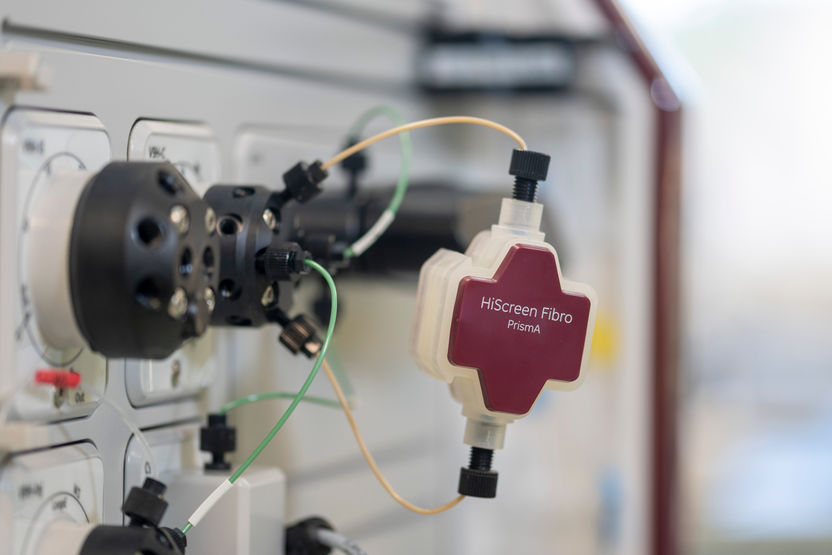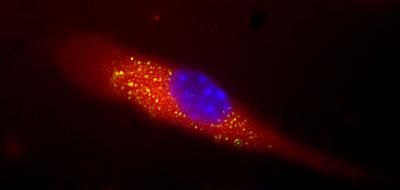New gene therapy for epilepsy provides on-demand release of endogenous substance
Teams of researchers from Charité - Universitätsmedizin Berlin and the Medical University of Innsbruck have developed a new therapeutic concept for the treatment of temporal lobe epilepsy. It represents a gene therapy capable of suppressing seizures at their site of origin on demand. Having been shown to be effective in an animal model, the new method will now be optimized for clinical use.

The new therapeutic concept works by inserting an additional gene in this area of the brain, which prompts cells to release dynorphin on demand.
Schwarzer/Medical University of Innsbruck
Epilepsy affects approximately 5 million people in Europe. The disorder is characterized by the recurrent and synchronized firing of groups of nerve cells. The propagation of these electrical discharges interrupts normal brain function and produces an epileptic seizure. The most common form of epilepsy is known as temporal lobe epilepsy (TLE), which is characterized by seizures originating in the temporal lobes. Long-term consequences of TLE can include memory problems as well as impaired learning and emotional control. Additionally, TLE patients' quality of life is severely affected by restrictions on their ability to work, drive a car or do sports. This is further compounded by the fact that the drugs used to treat TLE patients are often unable to adequately control the disorder yet are still associated with severe side effects. For this particular group of patients, surgical removal of the temporal lobe frequently remains the only treatment alternative. However, this treatment is associated with adverse cognitive outcomes and does not guarantee that patients will remain free from seizures. Working alongside Prof. Dr. Christoph Schwarzer (Medical University of Innsbruck's Department of Pharmacology), Prof. Dr. Regine Heilbronn (Director of the Institute of Virology on Charité's Campus Benjamin Franklin) developed a new therapeutic concept for drug-resistant TLE.
The new treatment method is based on targeted gene therapy. This technique involves the selective delivery of a specific gene to nerve cells within the area of the brain from which the epileptic seizures originate. The gene provides the cells with the information needed to synthesize dynorphins. These are naturally produced peptides which modulate neural activity. Once the gene has been delivered into the nerve cells, it remains there permanently. The cells then start to produce and store dynorphins. Explaining the new technique's mechanism of action, Prof. Schwarzer says: "High-frequency stimulation of the nerve cells, such as that seen at the beginning of a seizure, results in the release of stored dynorphins. Dynorphin dampens signal transduction and, as a result, the epileptic seizure doesn't spread." The neurobiologist and epilepsy expert goes on to add: "As the cells will only release this substance when needed, this type of gene therapy is referred to as 'release-on-demand'."
Using an animal model, the researchers were able to show that this gene therapy is capable of suppressing epileptic seizures for several months. Reduction of seizures also meant relief from their adverse effects on memory and learning. Moreover, no side effects have been observed so far. This is most probably due to the site-specific release of dynorphin and its short duration of action. Thanks to the substance's on-demand delivery, there was also no evidence of drug tolerance. The researchers then went on to test their new treatment concept using tissue samples obtained from epilepsy patients. They did so with great success, as dynorphin was shown to significantly reduce the severity and frequency of synchronized nerve cell activity in human epileptic tissue.
"The results from our study are encouraging, prompting us to hope that this new therapeutic concept could also be successful in humans," says Prof. Heilbronn. "As a transport vehicle for delivering the dynorphin gene, we are using a virus known as 'adeno-associated virus'. This has been approved for use in humans and is considered to be safe." Prof. Heilbronn and Prof. Schwarz hope to make this new gene therapy available for clinical use as rapidly as possible. "We are currently working on the viral vector which ferries the gene to its destination, in order to optimize it for use in humans," explains Prof. Heilbronn. "Our aim is to have this gene therapy ready for its first ever use in a clinical trial in just a few years." If the treatment is shown to be effective, this one-off treatment would offer a real alternative to patients on whom TLE drugs fail.
Original publication
Other news from the department science
Most read news
More news from our other portals
See the theme worlds for related content
Topic world Gene therapy
Genetic diseases once considered untreatable are now at the center of innovative therapeutic approaches. Research and development of gene therapies in biotech and pharma aim to directly correct or replace defective or missing genes to combat disease at the molecular level. This revolutionary approach promises not only to treat symptoms, but to eliminate the cause of the disease itself.

Topic world Gene therapy
Genetic diseases once considered untreatable are now at the center of innovative therapeutic approaches. Research and development of gene therapies in biotech and pharma aim to directly correct or replace defective or missing genes to combat disease at the molecular level. This revolutionary approach promises not only to treat symptoms, but to eliminate the cause of the disease itself.
























































